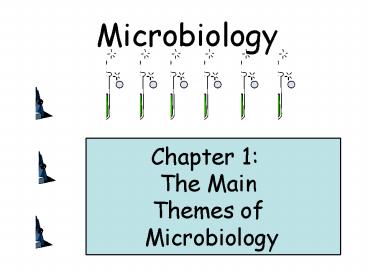Microbiology - PowerPoint PPT Presentation
1 / 18
Title: Microbiology
1
Microbiology
Chapter 1 The Main Themes of Microbiology
2
Where are they found??
- All over, from the depths of the ocean
(outerspace?) to all over your body! - For every cell that makes you - you, there are 10
more microorganisms on/in your body!
3
If conditions are right, one E.coli will
replicate to produce 68,517,875,736 more in just
12 hours. In 48 hours the total mass of E.coli
produced would weigh 4000x the mass of the earth.
4
What is Microbiology?
- And, what are microorganisms?
5
Groups of microorganisms
- procaryotes
- eukaryotes
- unicellular
- multicellular
- acellular (?)
- viruses
- viroids
- prions
- Lifestyle parasitic or free-living
6
The Importance of Studying Microbiology
- 1. m/o are causative agents of infectious
disease - 2. m/o play a critical role in ecological
systems - 3. Food
7
The Importance of Studying Microbiology
- 4. m/o occupy ecological niches on/in our bodies
- - in your colon 1010 m/o per gram, 80 of
feces by wt. - 5. m/o are important in medical and other
research...
8
The bacteria that cause gas gangrene and some
cases of food poisoning, replicates every 4
minutes! On the other hand, the bacteria that
cause TB replicates every 20 hours. The number of
Giardia to cause an infection is 1, the number of
Salmonella to cause an infection is 100,000,000
9
History of Micro.
- Hooke
- Leeuwenhoek
- Spontaneous generation theory
- Scientific method
- Pasteur
- Koch
- Flemming
- Jenner
10
Kochs Postulates
- There is evidence of the same microbe in every
case of the disease. - The microbe is isolated from infected subjects
and cultured in the lab. - The cultured microbes are inoculated into a
susceptible healthy host and the same disease is
observed. - The microbe is reisolated from the test subject.
11
HOW ARE M/OS NAMED?
- Genus
- species
- specific epitat
- what to underline/what to capitalize
- what does the name mean?
12
Size of those tinycreatures...
- Microbial dimensions
- measuring size
- Bacteria vs. Protista vs. Viruses, etc.
13
Microbiology
Chapter 3 Tools of the Laboratory
14
The 5 Is
- 1. Inoculaton
- culturing
- transport media
- broth
- agar
- semisolid media
- inoculation loop, inoculation needle, swab
- streak for isolation
15
The 5 Is
- 2. Incubation
- culture
- culture conditions
- 3. Isolation subculture, pure culture, mixed
culture, contaminated culture. - 4. Inspection - macroscopic and microscopic
observation - 5. Identification
16
The 5 Is
- Identification
- macroscopic morphology
- microscopic morphology
- staining characteristics
- motility
- size
- biochemical tests, animal tests
17
Microscopes
- What is each type of microscope used for
- Brightfield Scanning EM
- Darkfield Transmission EM
- Fluorescence
- Phase Contrast
18
Staining microbes
- The chemistry of stains
- Acidic stains/dyes
- Basic stains/dyes
- Simple staining
- Differential staining
- Gram staining
- Acid-fast staining
- Capsular staining
- Endospore staining































